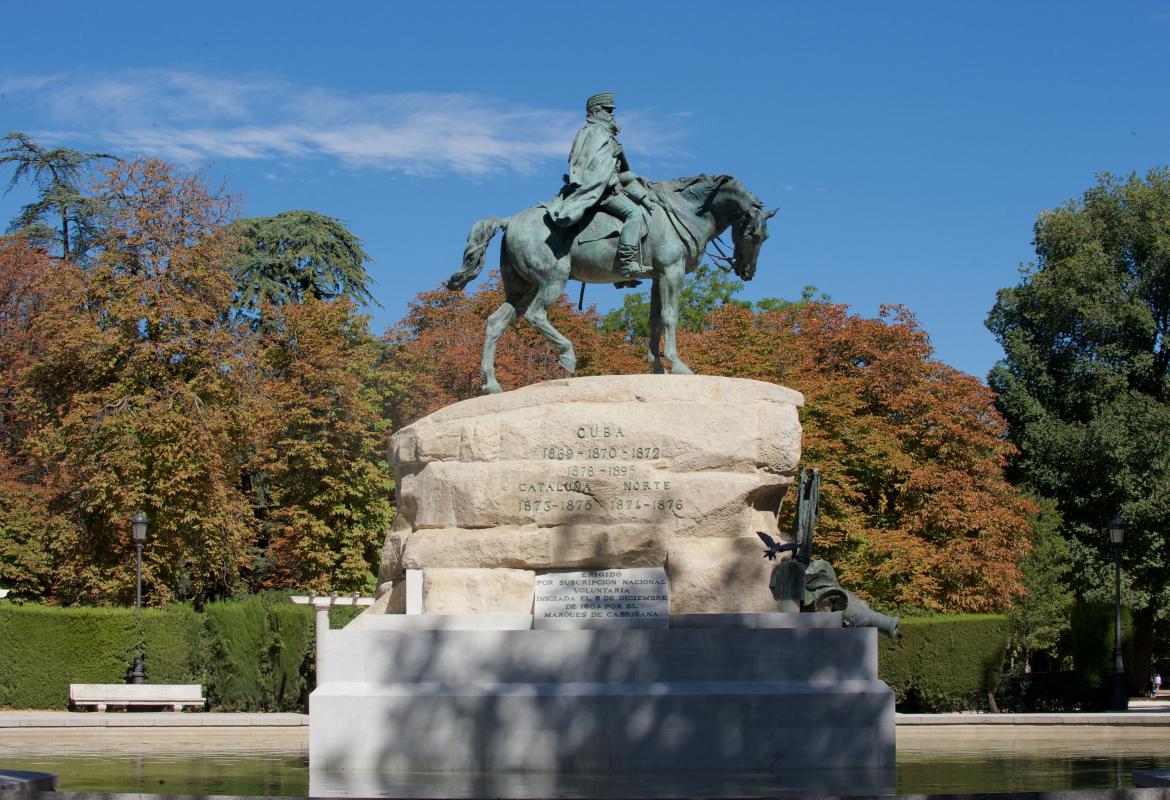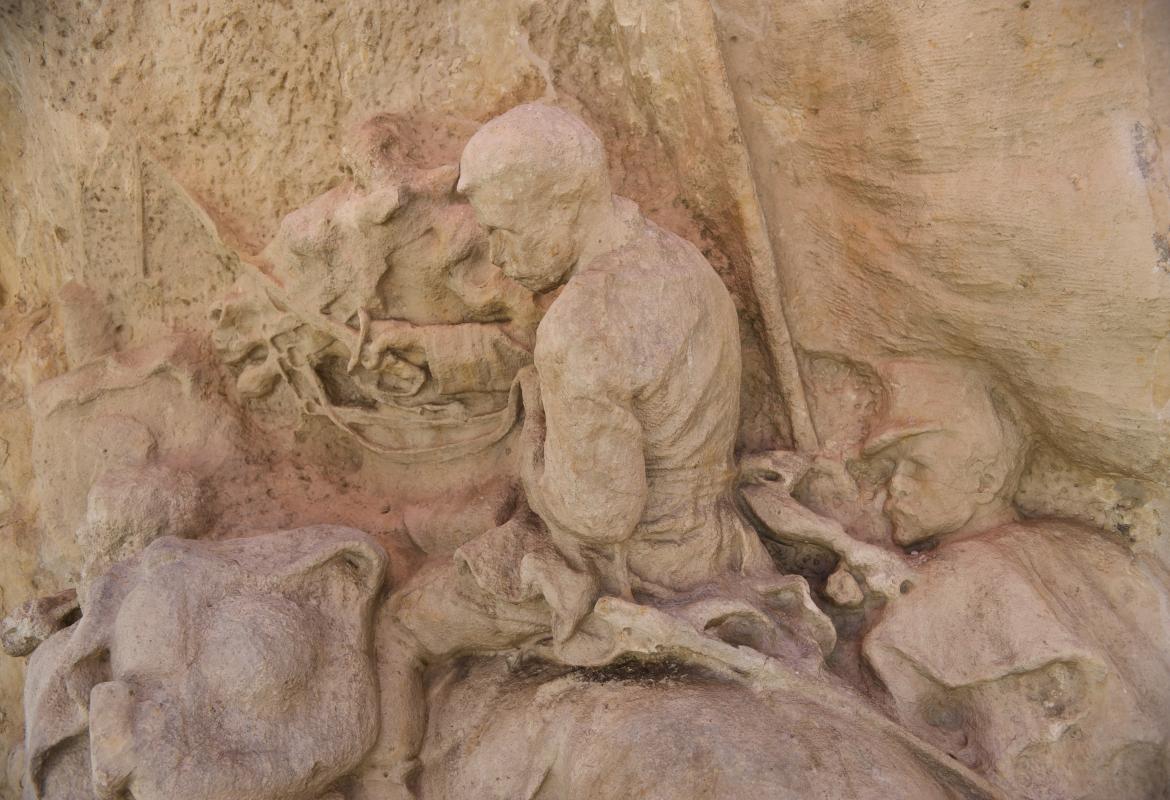

Equestrian Monument to General Martínez Campos
A Cultural
Image
Equestrian Monument to General Martínez Campos
The Equestrian Monument to General Martínez Campos, located in the Plaza de Guatemala in the Parque del Retiro, in Madrid, is a set made up of three superimposed pieces of different nature: a pedestal, a large rock and the equestrian statue itself.
The pedestal is a staggered prismatic piece, veneered in white marble, 7 meters long, 5 meters wide and 4 meters high. It does not have any special particularity, its sole function being to protect the monument and place it at a suitable height for its correct vision.
The crag or rocky top has the mission of contextualizing the statue of the soldier in campaign. It is configured as a natural element with the surface without roughing, with recesses and projections. This contribution was somewhat novel at the time, although there was the illustrious precedent of the equestrian statue of Tsar Peter the Great in Saint Petersburg, by Etienne Maurice Falconet, in which the rock, as a prow, was carved in almost geometric planes. and had a symbolic character. In Benlliure's work, the rock recreates a natural accident in keeping with the naturalistic character of the sculpture itself.
The alleged limestone crag, made up of numerous pieces fitted together, is in turn a support for different elements, such as tombstones and inscriptions that inform of their military campaigns, as well as information on the promotion and inauguration of the monument. It also serves as a background and support for a trophy cast in bronze, a classic iconographic element in military commemorative sculpture. On two of its faces it is carved with reliefs that illustrate one of his war campaigns.
The war trophy, as a tribute, is located on a bleacher in the front, with the rock as a backdrop. It is made up of two symmetrically arranged flags, of cavalry and infantry weapons, a drum, the remains of a cannon, a breastplate, a helmet and other weapons, with remains of a vegetable garland. On the trophy, with bronze letters on the stone, you can read the dedication, "To General Martínez Campos, model of patriots and soldiers, Spain."
The sculpted scene eats away at the rock on its north and west faces, in the manner of Roman narrative friezes or reliefs, and represents a lively episode of the battle of Los Castillejos (1860) in which Martínez Campos took part under the command of General Prim It is a relief in subtle gradation, from the cacti and firearms barely insinuated at the eastern end, to the high relief technique and almost round figures at the opposite end, ending in a figure of a soldier on horseback, where the use of different planes creates the effect of spatial illusion. Although it is a direct carving in the limestone, the surface treatment is reminiscent of modeling in clay, giving the sensation of having worked a soft and malleable material. Under the relief, in a marble band that fits the rock, is the inscription, "Africa 1859-1860". On the west or back face, an inclined plaque on the podium informs in bronze letters, “Inaugurated by HM King Alfonso XIII, January 28, 1907”.
On the south side of the rock, the dates of other campaigns, "Cuba 1869-1870-1872, 1878-1895", "Catalonia 1873-1875" and "North 1874-1876" are collected in loose bronze letters. Under the rock, another plaque inclined on the podium indicates "Erected by voluntary national subscription, initiated on December 5, 1904 by the Marquis of Cabriñana.
The equestrian statue of the general in field dress, one and a half times larger than life, crowns the monument. It is cast in bronze from a model made in clay by the Masriera y Campins Foundry in Barcelona.
It is a representation of great realism, absolutely naturalistic in composition, gesture and details. It recreates the moment when the general stops his horse on a cliff, contemplating the horizon or perhaps the battlefield from his vantage point. He wears campaign clothing, high boots, a military cloak over his shoulders buttoned at the neck, and a military cap or hat. With his left hand he holds the horse's bridle, while he rests his right nonchalantly on his leg. All clothing is treated with great realism. The breeze moves the cloak slightly back and helps to give volume to the figure.
The face of the military man shows a strong temperament and reflects responsibility and regret. Benlliure has managed to perfectly capture the character of the general with his gesture and attitude, composing a psychological portrait far from the heroic tone so frequent in this type of representation.
The horse, which is coming to a stop, keeps its right hind leg raised and tilts its head, drawing an exceptional foreshortening, in a movement that denotes tiredness. His anatomy is treated with great vigor and naturalness, with numerous details of virtuosity such as the swollen veins, the girths or the tail and the mane blown by the wind.
The texture of the bronze preserves the imprint of the previous clay modeling, a technique in which Benlliure was a true master, avoiding smooth and polished surfaces. The rough and rough workmanship of the metal together with the sculptural power, gives the monument great plastic beauty.
Taking into account the overall and detailed qualities, the balance of volumes and the perfection of the forms, it can be said that Benlliure achieved one of the best equestrian statues of his time, worthy successor to other illustrious examples in the history of European art, being decorated for it with the Grand Cross of Military Merit.
Testimony of a historical moment marked in the collective feeling of the Spaniards for the loss of the last remains of the Colonial Empire, this work is, basically, a reflection on the role of the military in society, which connects in a natural and inevitable way with the spirit of the Generation of '98.
Valencia, 1862-Madrid 1947
He was born into a family with an artistic tradition. His father was a decorator and his three brothers, Blas, José and Juan Antonio, were painters.
He began his artistic teaching alternating painting and sculpture, within the guidelines of academic realism, first in Valencia with Francisco Domingo, then in Madrid with his brother José and later in Paris with Domingo Marqués.
A trip to Rome in 1879 decided him to dedicate himself entirely to sculpture, and he opened a studio in the Eternal City, where he lived until his final transfer to Madrid in 1896. His successful career began in 1884, with a Second Medal in the National Exhibition of Fine Arts. He obtained First Medals at the International Exhibitions in Berlin, Munich, Vienna, Paris and Buenos Aires, among others, perhaps the high point of his career being the award of the Medal of Honor at the Universal Exhibition of Paris in 1900 for a group of works , among which was the monument-mausoleum of the tenor Julián Gayarre.
He was Director of the Spanish Academy in Rome and the Museum of Modern Art in Madrid, as well as General Director of Fine Arts, being considered the official sculptor of the Bourbon Restoration. Among his extensive work, which covers various genres, such as medals, portraiture or religious imagery, monumental and funerary public sculpture occupies a prominent place, of which he left almost a hundred examples in Spain, Europe and Latin America.
His style, always within the parameters of naturalism, knew how to combine the nervous and fast modeling of the clay, which transferred even the fingerprints to bronze, with meticulous detail in the execution.
Since the middle of the XNUMXth century, both royalty and the aristocracy, the new bourgeoisie, the institutions and the political classes promoted the creation of monuments and sculptures to honor outstanding figures or commemorate transcendental events, in what has come to pass in call the Golden Age of monumental public sculpture. In these years the cities were urbanistically transformed, and coinciding with the development of the expansion plans, open spaces, squares, gardens and promenades were created, frequently designed to house sculptural monuments as distinctive elements.
Given the active role of the military establishment in political life, statues of high-ranking military men were frequently erected, the equestrian ones being the most representative due to the great iconographic tradition of this typology.
One of the most important figures in Spanish history and politics in the second half of the 1831th century is General Arsenio Martínez-Campos Antón (Segovia 1900-Zarauz 1874). After a few years of active military life in Africa, Mexico and Cuba, he led successive campaigns in peninsular territory to put down the Carlist insurrections and cantonal movements in Catalonia and Levante. In the convulsive year of XNUMX, when the government of the First Republic decided to banish him because of his monarchical sympathies, he moved to Sagunto, where he proclaimed Alfonso XII King of Spain, thus becoming a key figure in the Bourbon Restoration.
In 1876 he was promoted to captain general for war merits and for a short period he served as Deputy for the district of Sagunto.
In 1876 he was again assigned to Cuba as captain general of the island, defeating the insurgents and practicing a policy of tolerance, declaring total amnesty for those who relinquished their arms. In 1878 he signed the Peace of Zanjón, which gave the island greater autonomy and abolished slavery, ending ten years of war.
In 1879 he returned to the peninsula and was appointed President of the Council of Ministers and Minister of War by the Conservative Party. Disillusioned with Cánovas, he passed to the Liberal Party and was appointed Minister of War in the Government of Sagasta. In that period he created the General Military Academy based in the Alcázar of Toledo.
In 1893, being captain general of Catalonia, he suffered an anarchist attack. In that same year he went to Africa as head of the intervention army to quell the rebellion of the Rif tribes, which ended in 1894 with the signing of a peace treaty with Sultan Hassan I.
In 1895 the insurrection broke out again in Cuba and he was appointed Governor of the island. His pacifying policy was unsuccessful and he was relieved of his post for refusing to toughen measures against the insurgents. Back on the peninsula, he was appointed President of the Supreme Court of War and Navy, a position he held until his death.
General Martínez-Campos was considered in his time a model for his courage, moderation, tolerance and moral rectitude.
The first idea of dedicating a monument to him dates back to 1888 and came from the General Military Academy. After his death, the Marquis of Cabriñana promoted the erection of a monument by public subscription, which was favorably received by the Royal Family, the Government and the Army, the latter providing the necessary bronze for the smelting.
The sculptors Mariano Benlliure, Agustín Querol, Aniceto Marinas and Miguel Ángel Trilles offered to do it. Without carrying out any competition, the commission chaired by the Marquis de Cabriñana determined that all of them should present their proposals in April 1905. It was considered that the projects by Benlliure and Querol were the most successful and it was agreed that both would jointly carry out the monument, Benlliure the equestrian statue and Querol the pedestal.
Finally, due to the lack of agreement with Querol, who did not agree to divide the amount stipulated by the commission equally, the commission was carried out entirely by Benlliure. The work was modeled, carved and cast between 1905 and 1907, being placed in a roundabout in the Retiro Park and inaugurated by King Alfonso XIII on January 28, 1907.











